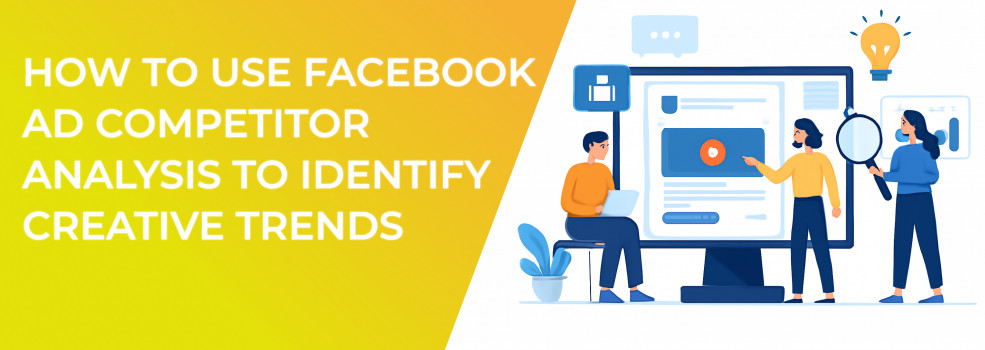When we talk about digital marketing, staying ahead of the competition is crucial. One of the best ways to fine-tune your Facebook advertising strategy is through competitor analysis. By analyzing the ads of other businesses in your industry, you can identify the creative trends that are driving engagement and ad performance. This enables you to refine your own ads, improve your Facebook ad optimization, and ultimately increase your ad performance and ROI.
Here’s a detailed guide on how to use Facebook ad competitor analysis to identify creative trends and optimize your campaigns for success.
Why Facebook Ad Competitor Analysis Matters
Facebook advertising is highly competitive, and it can be difficult to determine what strategies will resonate with your target audience. Competitor analysis helps you:
-
Identify high-performing creative strategies: See what types of ads (ad formats, ad copy, visuals) your competitors are using to capture attention and drive conversions.
-
Spot emerging trends: Get ahead of creative trends before they become mainstream.
-
Avoid costly mistakes: Learn from your competitors’ successes and failures to avoid pitfalls that could impact your Facebook ad performance.
-
Optimize ad spend: By identifying which ads and creative strategies are most effective, you can allocate your ad spend where it matters most.
Competitor analysis gives you a bird’s-eye view of the competitive landscape, so you can make informed decisions and optimize your Facebook ad strategy accordingly.
Step 1: Identify Your Competitors
The first step in conducting a Facebook ad competitor analysis is identifying your competitors. Competitors aren’t just direct businesses that offer the same product or service; they also include companies targeting the same audience as you, even if their offerings differ slightly.
To identify your competitors:
-
Look at direct and indirect competitors: Direct competitors are businesses that sell the same or similar products. Indirect competitors might offer alternatives or serve the same audience in a different way.
-
Check their Facebook presence: Use Facebook’s search bar to find competitors in your niche. Browse their pages and take note of businesses running active ad campaigns.
Once you have a list of competitors, you can start analyzing their Facebook ads using tools like Facebook’s Ad Library. This free tool gives you insight into all the active ads a business is running, allowing you to see exactly what kind of content they’re using to target their audience.
Step 2: Analyze Ad Creatives for Performance Indicators
The next step is to dive deep into the specific elements of your competitors’ Facebook ads. Pay attention to the ad formats, messaging, visuals, and overall strategy they are using. These factors contribute to Facebook ad performance and ad optimization.
Analyze the key components of competitor ads — ad copy, visuals, and CTAs — to understand what works best.
-
Ad Formats: The type of ad format your competitors use can offer valuable insights into what resonates with their audience. Look at whether they are using:
-
Carousel ads: Great for showcasing multiple products or features in one ad.
-
Video ads: Highly engaging and effective in driving interactions. Video ads typically generate a higher click-through rate (CTR) than static ads.
-
Single image ads: Simple and straightforward, but still effective when paired with the right messaging.
-
Slideshow ads: Lightweight video ads that offer a similar experience without the high production costs.
-
-
Ad Copy and Messaging: Pay attention to the tone, length, and focus of the ad copy. Successful ads typically:
-
Address pain points of the audience, providing a solution.
-
Emphasize benefits over features.
-
Use power words like “exclusive,” “limited time,” or “free” to increase urgency.
-
Keep it concise while offering clear value.
-
-
Visuals and Branding: The visuals in an ad are crucial for grabbing attention. You should focus on:
-
Consistency in branding: Are the logos, colors, and imagery consistent across all ads? This helps build brand recognition.
-
Emotion-driven imagery: Are they using images that evoke certain emotions (e.g., happiness, excitement, curiosity)?
-
Professional quality: High-quality visuals often correlate with better engagement and trust.
-
-
Call-to-Action (CTA): A strong CTA drives action. Look at what kinds of CTAs your competitors are using:
-
Shop Now
-
Learn More
-
Sign Up
-
Get Started
The CTA should align with the ad’s goal. If the goal is to increase sales, the CTA will likely be more direct (e.g., “Buy Now” or “Shop Today”). If the goal is to generate leads, a softer CTA like “Sign Up” might be more appropriate.
-
By analyzing these elements, you’ll start to see patterns and strategies that are working for your competitors.
If you're noticing unexpected issues like ‘Ad Set May Get Zero’ during your ad analysis, check out our guide on how to fix this issue for troubleshooting tips to improve performance.
Step 3: Identify Creative Trends
As you analyze your competitors' ads, begin to look for overarching creative trends. These trends can indicate what’s resonating with the audience and what you should consider incorporating into your own ads.
Here’s what to look for:
-
Ad Copy Trends: Are your competitors using a specific tone or style of messaging? For example, if many of them use humor, it might suggest that humor is a good strategy for engaging their target audience. Similarly, if they all use urgency (e.g., "Hurry, limited time offer"), you may want to test urgency in your own ads.
-
Visual Trends: Look for patterns in the imagery. Do your competitors often use lifestyle shots, product-focused imagery, or user-generated content? Identifying these trends will give you a good idea of what works best visually.
-
Promotions and Offers: Many competitors might focus on certain types of promotions, such as discounts, free trials, or bundle offers. Seeing these trends can give you ideas on how to position your products or services more effectively.
By spotting these creative trends, you can tweak your own ads to better align with what the audience finds appealing, thus improving ad performance.
To fine-tune your audience and maximize engagement, refer to our Facebook ad targeting guide to learn how to effectively reach the right people.
Step 4: Optimize Your Facebook Ads
Now that you’ve identified trends and insights, it’s time to optimize your own Facebook ads. Here’s how you can implement what you’ve learned:
-
A/B Testing: Run A/B tests to experiment with different ad formats, ad copy styles, visuals, and CTAs based on your competitor analysis. For example, if you noticed that video ads are performing well for your competitors, try running a video ad to see if it increases engagement.
-
Budget Allocation: Allocate your ad spend to the ad types and creative strategies that your analysis shows perform best. Use Facebook’s ad performance metrics like Cost Per Click (CPC), Click-Through Rate (CTR), and Return on Ad Spend (ROAS) to gauge which ads are driving the most value.
-
Refining Targeting: Use the audience data from your competitor analysis to refine your own targeting. If your competitors are targeting similar demographics or interests, you can experiment with targeting the same groups. Facebook’s detailed targeting options allow you to narrow down your audience, ensuring your ads reach the right people.
-
Focus on Visuals and CTA: If you see that your competitors' ads with high-quality images or certain types of CTAs are performing well, incorporate similar elements into your ads. Keep in mind, however, that your visuals should still feel unique to your brand.
Choosing the right campaign objective is crucial to aligning your ad with its goals. To understand which objective suits your needs, check out our Meta Ad Campaign Objectives guide.
Step 5: Monitor and Adjust
Competitor analysis is not a one-time task. The digital landscape, especially on Facebook, is constantly evolving. New trends, features, and best practices emerge all the time. To stay ahead, continuously monitor your competitors’ ads and adjust your strategy based on the latest insights.
-
Set up regular check-ins: Review your competitors’ Facebook ads every few weeks to stay updated on new strategies.
-
Track ad performance: Regularly review your Facebook ad performance metrics and optimize your strategy based on what’s working.
Conclusion
Facebook ad competitor analysis is a powerful tool for identifying creative trends and improving ad performance. By keeping a close eye on your competitors’ ads, analyzing their creative strategies, and adapting your approach accordingly, you can fine-tune your campaigns to outperform the competition.
By continuously monitoring and optimizing your Facebook ads based on competitor analysis, you can ensure that your campaigns are not only relevant but also highly effective, driving greater engagement and maximizing return on ad spend (ROAS).

